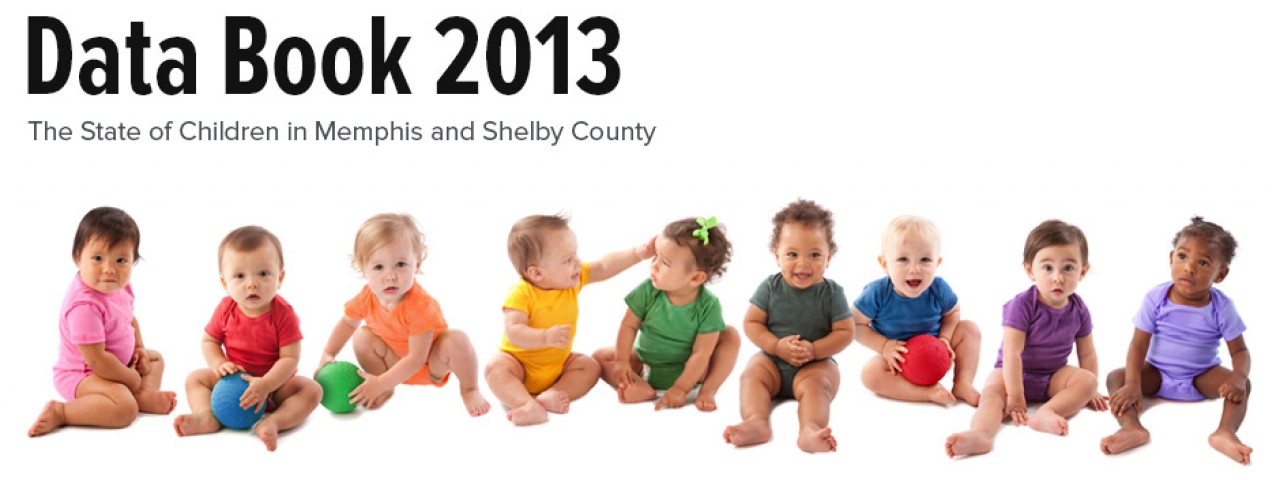Special Interest Section: Child Sexual Abuse
Child sexual abuse can take many forms.
Child sexual abuse is the sexual exploitation of a child achieved by persuasion, coercion, force, or the threat of force.1 Child sexual abuse can take many forms, ranging from verbal, non-contact abuse to sexual assault. Examples include, but are not limited to, an encounter with exhibitionism (or “flashing”), over-the-clothes fondling by an acquaintance, ongoing abuse by a relative or family member, and exploitation through prostitution or pornography.
Using data from national research and local statistics provided by the Memphis Child Advocacy Center (CAC), this section examines child sexual abuse and its impact on Shelby County children.
Child sexual abuse is epidemic.
The Centers for Disease Control and Prevention has identified child maltreatment - which includes sexual abuse - as a public health problem and a prevention priority.2 The statistics are startling: A 2008 national survey showed 9.8 percent of children had been sexually victimized before they were 18 years of age.3
Shelby County has the highest number of reports of abuse in the state.
- 5,229 reports were made in 2010.4
- In 2011, there were 790 substantiated reports in Shelby County of forcible rape, forcible sodomy, sexual assault with an object, forcible fondling, incest, or statutory rape against minors.5
Childhood sexual abuse threatens brain development, physical health, and emotional well-being.
Children who are sexually abused, especially those who grow into adulthood without appropriate intervention, are at higher risk for a wide range of cognitive, emotional, and social problems that can persist into adulthood.
Traumatic experiences such as sexual abuse impact the brain, flooding synapses with stress hormones produced by the body in response to threatening situations.6 This can be especially detrimental to young children, whose brains are still developing. Persistent activation of the stress response system can disrupt healthy brain development.7 Furthermore, alterations in stress-related brain regions can have lifelong effects on a child’s coping skills.6
Early trauma also threatens physical health. Survivors of child sexual abuse are at increased risk for obesity, heart disease, chronic pain, sleep problems, and immune-related disorders.8,9 Psychological effects of child sexual abuse include Post-traumatic Stress Disorder, depression, relationship difficulties, substance abuse, eating disorders, and even suicide attempts.9–12
Girls who are sexually abused are more likely to engage in risky sexual behavior, to become pregnant as a teen, and to have a sexually transmitted disease.9,10,13
Child sexual abuse costs our communities as well. The national economic cost of child sexual abuse is estimated between $23 billion and $35 billion annually and includes immediate costs like medical care as well as longer-term costs related to poor quality of life in adulthood.14,15 In Shelby County, the estimated immediate cost of child sexual abuse is $10 million and the long-term cost is $105 million.15
National data show that many children never tell.
Because many children don’t tell anyone after being sexually abused, the official statistics are likely to represent only a fraction of the total number of children who are victims. Delays and non-disclosure are more common in cases involving younger children, multiple assaults and abuse by a relative.16
A national survey of women who were raped as children confirmed that many children do not come forward after being sexually abused.
- 18 percent of surveyed women told someone within 24 hours of their assault.
- 20 percent told 1 to 12 months after the assault.
- 63 percent disclosed a year or more after the assault. About half of these women had never told anyone prior to the survey.16
Local data from the Memphis Child Advocacy Center reveals a similar trend (FIGURE 1). Among 162 children referred to therapy between July 2011 and June 2012 following a disclosure of abuse.
- About 33 percent had come forward within 24 hours.
- Another 19 percent disclosed within a month.
- Almost 20 percent waited between 1 and 12 months.
- 29 percent waited a year or more.
FIGURE 1: Percent of Children by Timing of Disclosure of Sexual Abuse, Shelby County, 2012
FIGURE 1 shows that only about one-third of children seen at the Memphis CAC told someone within 24 hours that they had been abused, and almost 30 percent waited a year or longer.
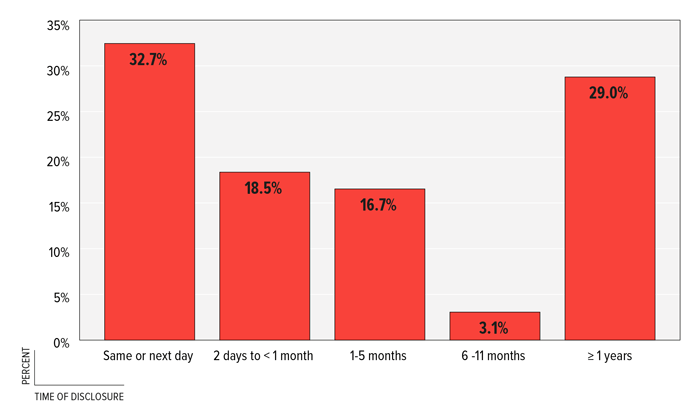
Source: Memphis Child Advocacy Center. Unpublished Data, 2012
All children are vulnerable to sexual abuse.
Children are vulnerable to child sexual abuse regardless of family structure, family income level, neighborhood, race, religion, age, or gender. When looking across all types of sexual victimization, prevalence rates do not vary based on household income or race. Rates are similar for boys and girls until around age 14, after which sexual victimization is substantially higher among females.17,18
The average age of children seen for therapy services at the Memphis Child Advocacy Center last year was 10.2 years. Of the 257 children who received therapy,
- 81 percent were female and 19 percent were male
- 72 percent were African-American
- 20 percent were white
- 7 percent were Hispanic
Most perpetrators are not strangers.
Perhaps contrary to common belief, national research shows that in the majority of cases children are victimized by someone known to them, whether a family member or an acquaintance.17 A similar trend is seen among children treated at the Memphis Child Advocacy Center: 93 percent of offenders are known by the child – an unrelated juvenile, a related juvenile or adult, or a trusted adult acquaintance (FIGURE 2).
Offenders do not fit a narrow profile.
A research study with unincarcerated, self-described sex offenders seeking treatment in two sites – Memphis and New York – revealed a wide range of ages and backgrounds.19
- Two-fifths had finished at least one year of college.
- Nearly two-thirds were employed.
- Almost half were currently in, or had been in, a heterosexual relationship with an adult.
Too often, abuse is an ongoing trauma.
Child sexual abuse typically is not an isolated incident. In a national survey of women raped as children, three-quarters reported that they were repeatedly assaulted over the course of a year or longer.16
One out of every four children seen at the Memphis CAC endured abuse for more than a year (FIGURE 3).
Many of these children are being violated aggressively. Over half of children seen at the Memphis CAC reported assaults involving penetration of some kind (FIGURE 4).
FIGURE 2: Percent of Children by Relationship to Offender, Shelby County, 2012
FIGURE 2 shows that 93 percent of offenders are known by the child.
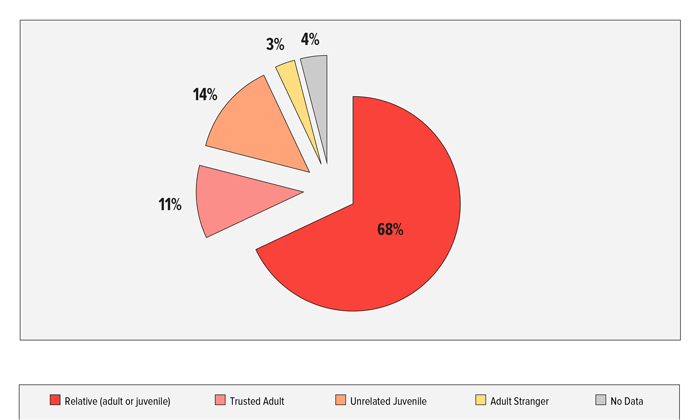
Source: Memphis Child Advocacy Center. Unpublished Data, 2012
FIGURE 3: Percent of Children by Duration of Abuse, Shelby County, 2012
FIGURE 3 indicates that one out of every four children seen at the Memphis CAC endured abuse for more than a year.
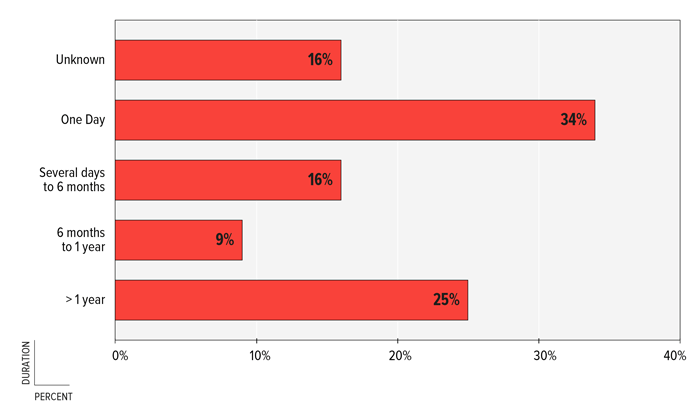
Source: Memphis Child Advocacy Center. Unpublished Data, 2012
FIGURE 4: Percent of Children by Type of Sexual Abuse, Shelby County, 2012
FIGURE 4 indicates that over half of children seen at the Memphis CAC reported assaults involving penetration of some kind.
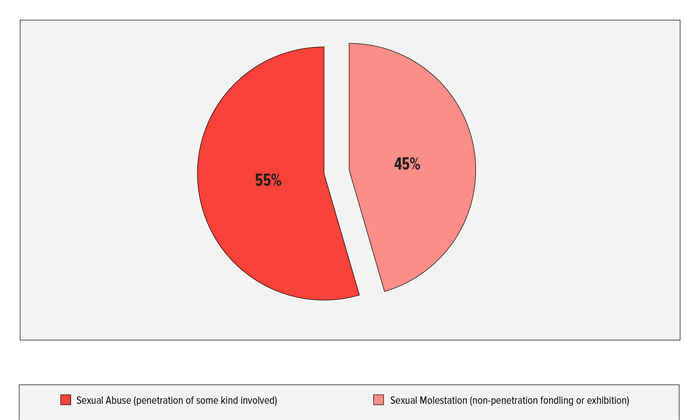
Source: Memphis Child Advocacy Center. Unpublished Data, 2012
Not all victims suffer long-term consequences.
Sexual abuse poses a grave threat to children’s healthy development. However, not all abused children are destined for poor outcomes. The likelihood of long-term negative effects is strongly related to the severity and duration of abuse and the child’s relationship to the perpetrator.20
Supportive relationships with key caregivers or extended caregivers can help children cope after traumatic experiences.9 Appropriate treatment can also reduce the impact of abuse: Cognitive-behavioral therapy (the approach used by the Memphis CAC) has been shown to be particularly effective at alleviating stress symptoms, reducing victims’ sense of stigma, and providing children with the knowledge and skills they need to overcome the trauma of sexual abuse.21
- Code, United States. Title 42-chapter67, section 5106g. [Online] [Cited: January 29, 2013.] http://uscode.house.gov/download/pls/42C67.txt.
- Hammond WR. Public health and child maltreatment prevention: The role of the Centers for Disease Control and Prevention. Child Maltreatment. 2003; 8(2):81–83.
- Finkelhor D, et al. Violence, abuse and crime exposure in a national sample of children and youth. Pediatrics. 2009. 124(5):1411–1423.
- Annie E Casey Foundation. Kids Count Data Center. [Online] 2010. [Cited: March 15, 2013.] http://datacenter.kidscount.org/data/bystate/Rankings.aspx?state=TN&loct=5&by=a&order=a&ind=3023&dtm=13283&tf=133.
- Tennessee Bureau of Investigation. Tennessee Crime Statistics Online. [Online] [Cited: February 22, 2013.] http://www.tbi.tn.gov/tn_crime_stats/crime_stats_online.shtml.
- Gaskill RL, Perry BD. Child sexual abuse, traumatic experiences, and their impact on the developing brain. In P. Goodyear-Brown, ed. Handbook of Child Sexual Abuse: Identification, Assessment, and Treatment. Hoboken, NJ: John Wiley and Sons, Inc., 2012.
- Perry BD, Pollard R. Homeostasis, stress, trauma, and adaptation: A neurodevelopmental view of childhood trauma. Child and Adolescent Psychiatric Clinics of North America. 1998; 7(1):33–51.
- Gilbert R, et al. Burden and consequences of child maltreatment in high-income countries. The Lancet. 2009; 373:68–81.
- Kendall-Tackett K. The long-term health effects of child sexual abuse. In P. Goodyear-Brown, ed. Handbook of Child Sexual Abuse: Identification, Assessment, and Treatment. Hoboken, NJ: John Wiley and Sons, Inc., 2012.
- Mullen PE, et al. The long-term impact of the physical, emotional, and sexual abuse of children: A community study. Child Abuse and Neglect. 1996; 20(1):7–21.
- Chapman DP, et al. Adverse childhood experiences and the risk of depressive disorders in adulthood. Journal of Affective Disorders. 2004; 82:618–647.
- Dube SR, et al. Long-term consequences of childhood sexual abuse by gender of victim. American Journal of Preventive Medicine. 2005; 28(5):430–438.
- Senn TE, Carey MP, Coury-Doniger P. Self-defining as sexually abuse and adult sexual risk behavior: Results from a cross-sectional survey of women attending an STD clinic. Child Abuse and Neglect. 2011; 35(5):353–362.
- Miller TR, Cohen MA, Wierseman B. Victim costs and consequences: A new look. The National Institute of Justice. [Online] 1996. [Cited: February 25, 2013.] http://www.ncjrs.gov/pdffiles/victcost.pdf.
- Darkness to Light. The Economic Impact of Child Sexual Abuse: What are the costs to your community? Darkness to Light. [Online] [Cited: February 25, 2013.] Estimate based on Census Bureau 2011 population estimate of 935,088.
- Smith DW, et al. Delay in disclosure of childhood rape: Results from a national survey. Child Abuse and Neglect. 2000; 24(2):273–287.
- Finkelhor D, et al. The victimization of children and youth: A comprehensive, national survey. Child Maltreatment. 2005; 10(1):5–25.
- Finkelhor D, Ormrod R, Turner HA. The developmental epidemiology of childhood victimization. Journal of Interpersonal Violence. 2009; 24(5):711–731.
- Abel GG, et al. Self-reported sex crimes of non-incarcerated paraphiliacs. Journal of Interpersonal Violence. 1987; 2(1):3–25.
- Kendall-Tackett KA, Williams LM, Finkelhor D. Impact of child sexual abuse on children: A review and synthesis of recent empirical studies. Psychological Bulletin. 1993; 113(1):164–180.
- Finkelhor D. The prevention of childhood sexual abuse. Future of Children. 2009; 19(2):169–94.
